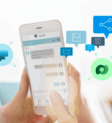How Chatbots Help HR Managers Improve Employee Experience and Reduce Cost per Contact

Imagine the spike in productivity if each of your employees is empowered with a knowledgeable and personalized assistant at no further resource cost. With the proliferation and high adoption of chatbots, this is no longer fiction, it is a living reality. HR managers are able to experience an ideal vision of this era — realize a digitally, self-service and employee-driven environment supported by people representing the organization’s HR function. Chatbots, through the interactive and conversational interface, are making it happen.
Chatbots enabled by machine learning have a steeper and faster learning curve than any human. Especially when knowledge base needs to be updated, they do not require continuous training in comparison to people. Primarily, chatbots are deployed where the push and pull capabilities need to be used.
With push features, chatbots strengthen internal communications by sending out announcements and notifications. It is also used to send out training modules and updates to the employees’ inbox. The other areas where chatbots are used are the onboarding process and employee engagement.
Using pull features, chatbots have provided support in areas like recruitment, employer brand building, training, FAQs and virtual assistants. Users can use bots to pull information and also bots can push personalized updates/anomalies/trends to the user.

Visionary companies choosing the AI route are already reaping results by employing chatbots to improve different functions of the Human Resource (HR) department, enhance employee experience and reduce Cost per Contact (CPC).
CHATBOTS ADDING CAPABILITIES TO HUMANS
It is easy to identify the sub-functions where chatbots have flourished. Apart from that, there are some core capabilities that chatbots add to humans, enhancing their skill sets. These capabilities aid in enhancing employee experience, something that has a direct influence on ROI.
INTEGRATION WITH OTHER DEPARTMENT SOFTWARE BEHEMOTHS:
Chatbots may seem simple as an interface, but they have the brain of their own at the backend. Apart from HRM, they integrate with cross-functional management solutions like ERP, CRM, analytics, accounting and the intranet. These management suites hold large data sets and need to talk to each other. Chatbots become the linchpin that binds data across the organization and keeps the cohesiveness of information intact.
ESCALATION TO HUMAN-LED HIERARCHIES:
80% of query management and responses are managed by the chatbots itself. However, those interactions that require the attention of a human agent are escalated automatically by the chatbot whenever necessary. Chatbots are capable of skill-based routing which helps in prompting to the right person with the relevant issue.
GOVERNANCE & CONFIDENTIALITY:
Unfortunately, with humans there is a possibility of compromised governance and confidentiality. However, chatbots are programmed to adhere to policies and retain confidentiality of both the organization and the employee in interaction. Well structured chatbots are supported by basic security protocols to avoid fidelity, such as — identity authentication using login credentials, two-factor authentication, encryption, and self-destructing messages.
ADMINISTRATION, EXTRACTION, AND REPORTING:
Interactions and conversations are reasons that attract the HR guild in enhancing employee experience. However, chatbots also support HR managers by fulfilling administrative operations, extraction of documents and information on-demand and reporting capabilities based on the information gathered from conversations. The output that a chatbot provides is a lot more data-validated, objective than biased, as it occurs to be the case with human agents.
Chatbots are not a mere technological intervention for HR managers. They also influence the bottom line.
CHATBOTS AND ITS ROI
By 2022, chatbots are expected to cut business costs by $8 billion. Chatbots have a direct influence on some of the key metrics that matter to an HR manager. A Boston Consulting Group (BCG) study showed that employee experience has the ability to increase ROI anywhere between 1.8x to 3.5x.
Employee experience is a compound of culture, technology, and physical space. Chatbots have the ability to influence all three aspects in different ways.
COST PER CONTACT:
While the number of calls that an employee attends to can reach its pinnacle, the total operational costs can be reduced heavily with the use of chatbots. No matter how efficient the resource managing the calls is, there is always the pressure of time and performance that may act counter-productively in improving cost per contact.
Traditional specialists have suggested some solutions that help in reducing the cost per contact (CPC) — utilizing skill-based routing, interactive voice response and call back feature of IVR. A chatbot, when programmed, is intelligent enough to implement skill-based routing without the involvement of a human. It uses hierarchies and skill tags to perform this task independently. Instead of a callback, chatbots can send reminders and proactive updates on behalf of an associate.
One major cost saving comes from replacement of calls to chats. Chatbots can help businesses save on costs by speeding up response times, freeing up agents for more challenging work, and answering up to 80% of routine questions. Over the years, there is a rise in preference of text-based messaging over calls.
Average abandon time (ABT) metric influences the reduction of CPC. This is highly determined by the skill sets and degree of each skill of your employee. However, the issue of abandon time is reduced to negligible with the use of chatbots. The major reason for this issue is because of the human errors that are bound and imperative by the very nature. With chatbots, that will not be the case.
The other positive effects on cost efficiency with the use of chatbots would reflect as increased employee productivity, reduced time spent on recruitment and no year-on-year hikes for a chatbot.
AREAS WHERE CHATBOTS ARE ALREADY AIDING HR MANAGERS
Chatbots are enabling automation of HR through conversational experiences. It is most applicable to tasks that are repeatable. Some of the areas where chatbots are thriving are:
FAQS & TRAINING:
Employees often run through the long-cycle of time consuming training sessions and coaching mechanisms. A chatbot that is typically made available 24×7 allows employees to get trained in an agile mode and round the clock, adding flexibility to their work life. By consuming these conversational training modules, in the form of FAQs, mini-questionnaires and tests. For instance, to resolve queries and update knowledge in the IT space, IT Helpdesk BOT provides access to the knowledge for employees across the organization. Training bots also take care of administrative aspects like sending reminders and fixing coach appointments.

EMPLOYEE ENGAGEMENT:
It is not just about surveys and SLAs, it is about understanding the employee and making them feel comfortable at their workplace. To achieve great employee experience can’t be just the senior management’s job, engagement happens from everywhere. This becomes true only when every employee is empowered to take action — through a digital self-service environment. This compels an engagement tool to have the ability to communicate with every employee and work towards building a community. An all-rounded employee engagement bot works on appraising peers, create loyalty programs and get the employee to engage through a conversation, exclusive for Slack.

EMPLOYER BRAND:
Building an employer brand is the foundation for good recruitment. Chatbots talk to communities of potential candidates on different platforms, as the organization itself, to attract talent. This does not sound like enterprise bots but actually, do their job. They are found in more gregarious communities like Facebook, Slack, via Mobile and others. They also have the functionality of building the employer brand globally. Chatbots extract data from multiple systems like intranets, CRM applications like Salesforce and LOB application and act as a single point of contact. Employees can perform transactions with their LOB systems. If the data requested is too complex to portray in a chat window, the bot gives a link to the respective dashboard/page in the app/intranet.

RECRUITMENT:
From candidate search engines to applicant tracking systems (ATS), there are many tasks that require automation. While using ATS, the process of parsing played a major role in extracting information. With Chatbots, candidate information is gathered across different channels over a conversation with the candidates. Candidates can also ask the chatbot about questions pertaining to a job description, company culture, and interview process.
ON-BOARDING:
It is not just for the company to draw necessary documents and information using an on-boarding chatbot, it is also for the new employee to ask several questions about the work, reporting manager, rules of the land, missing laptop or ID card and so on. SAP Success Factors has an integrated onboarding chatbot called ‘Onboarding Buddy’ that executes seamless onboarding across multiple offices around the globe and for different newcomers simultaneously. With a chatbot around, employees no longer need to hover around the HR department for every small issue. Chatbots can provide a real-time self-service option to all users. These services could include leave application and management, employee onboarding, setting up reminders, etc.
These are just a few verticals where chatbots are being harnessed for their omnipresence and conversational abilities. The exciting part is that they also have some positive cost implications on the KPIs.
ADOPTION OF CHATBOT USING A BOT PLATFORM — BOTCORE.AI
This just illustrates that HR is evolving fast by anchoring on chatbots that can speak like a human and execute repetitive tasks. To keep pace with such speed, you would have to get started with an environment like a bot builder platform that will provide you with the necessary tools and expertise to develop bots for diverse needs.
Botcore.ai is one such platform that allows you to build versatile chatbots, that will further aid in enhancing engagement and productivity. Apps are fast being replaced by chatbots that can perform repetitive tasks in a conversational interface. Get started with a new chatbot here.
If you’d like to learn more about this topic, please feel free to get in touch with one of our experts for a personalized consultation.

A Return To Workplace Checklist For HR Leaders
Jagan Jami is the COO @ Acuvate Software. He heads the delivery unit at Acuvate which had delivered 100+ intranets to companies across the globe. Jagan has been working with global CIOs and other business heads and consulted them on Intranet evolution and current trends.






Jagan Jami